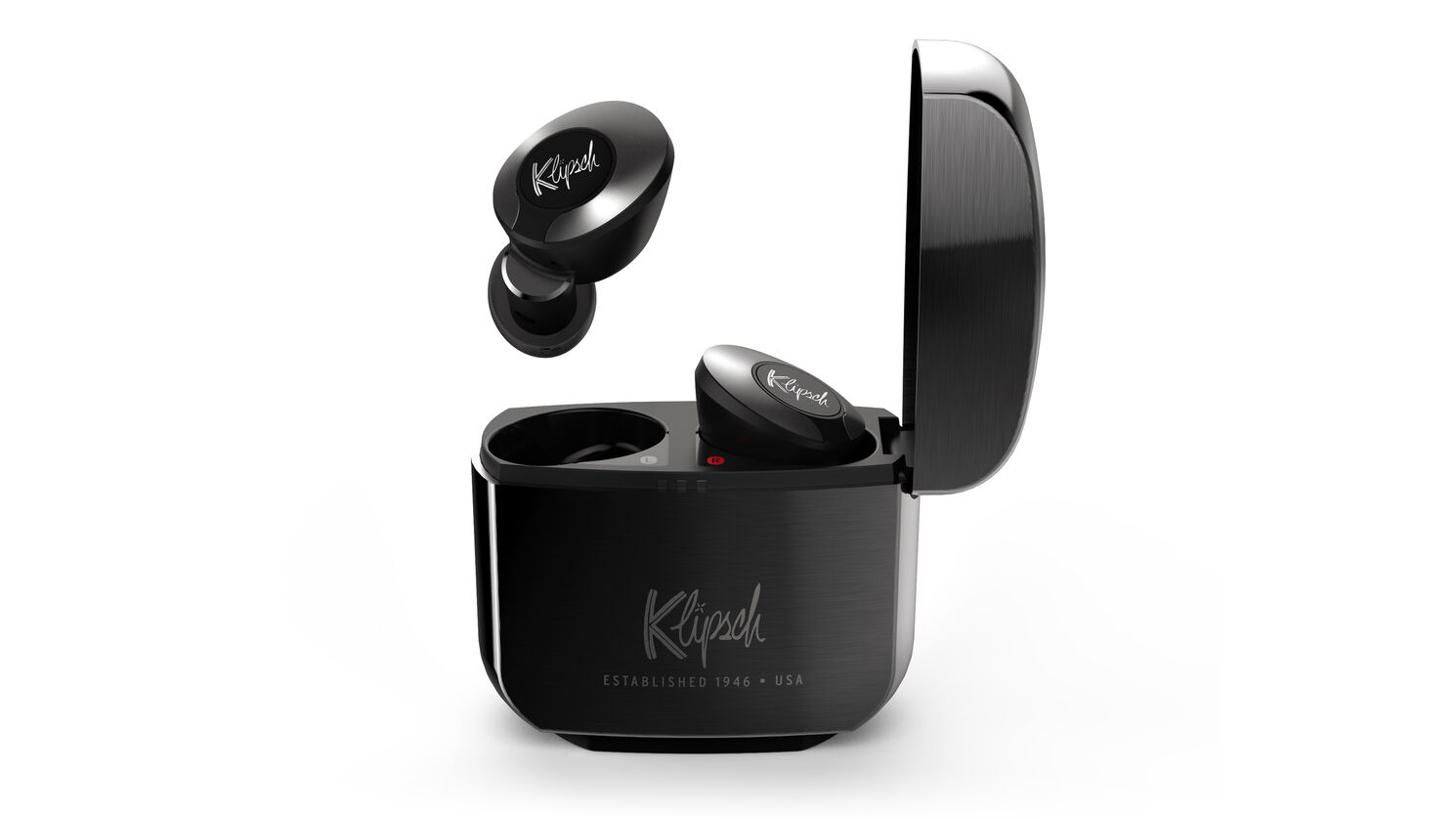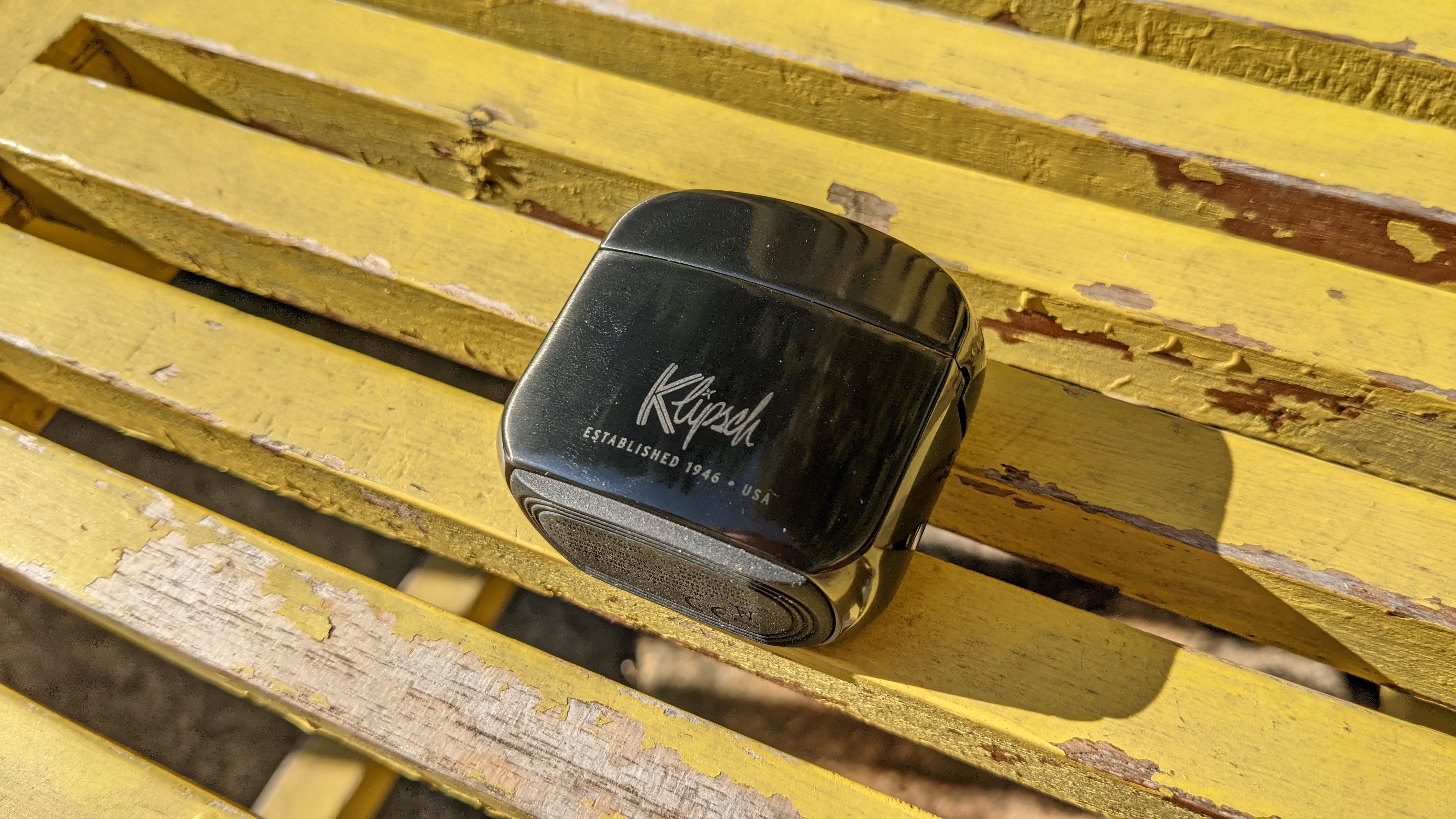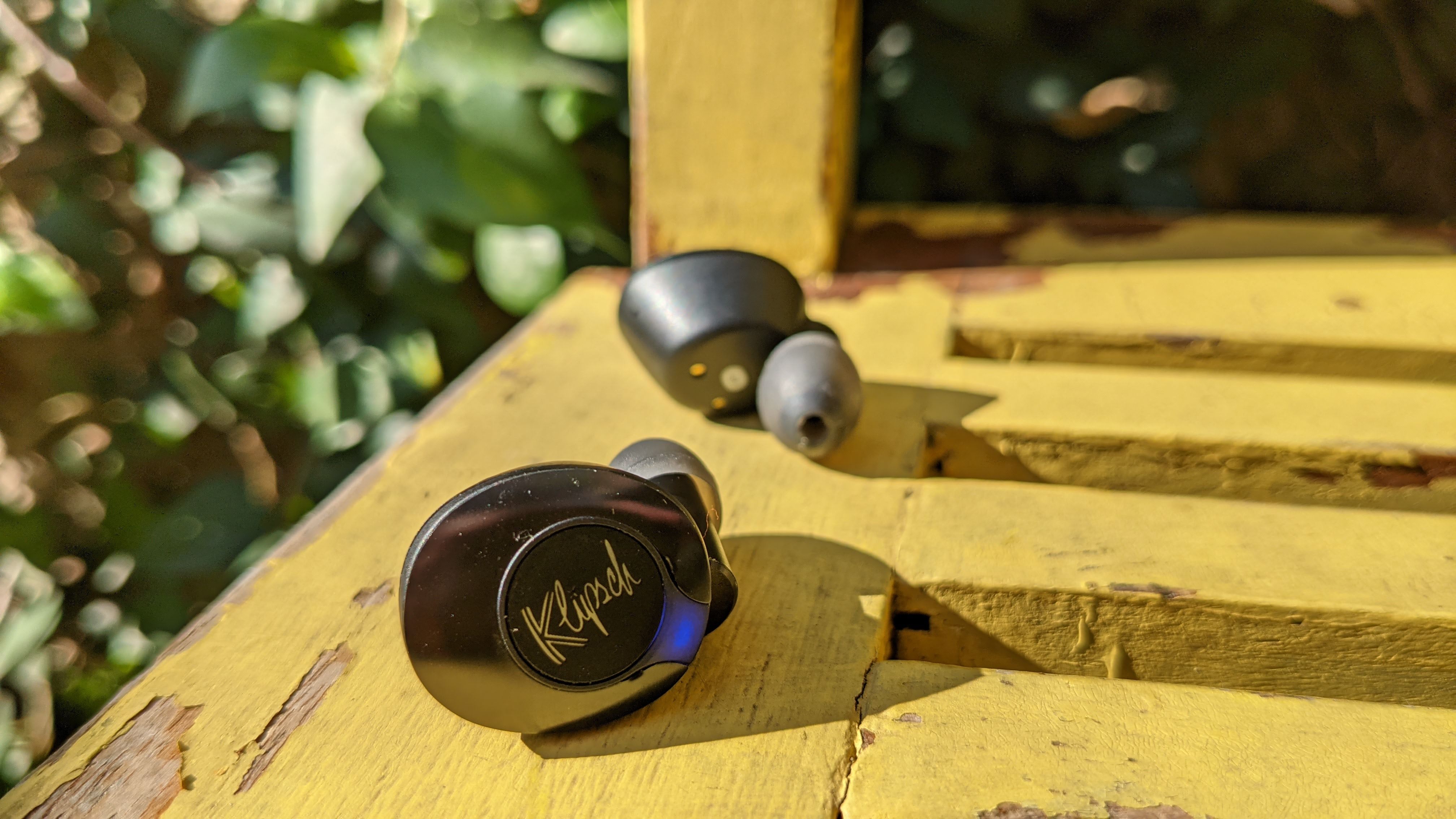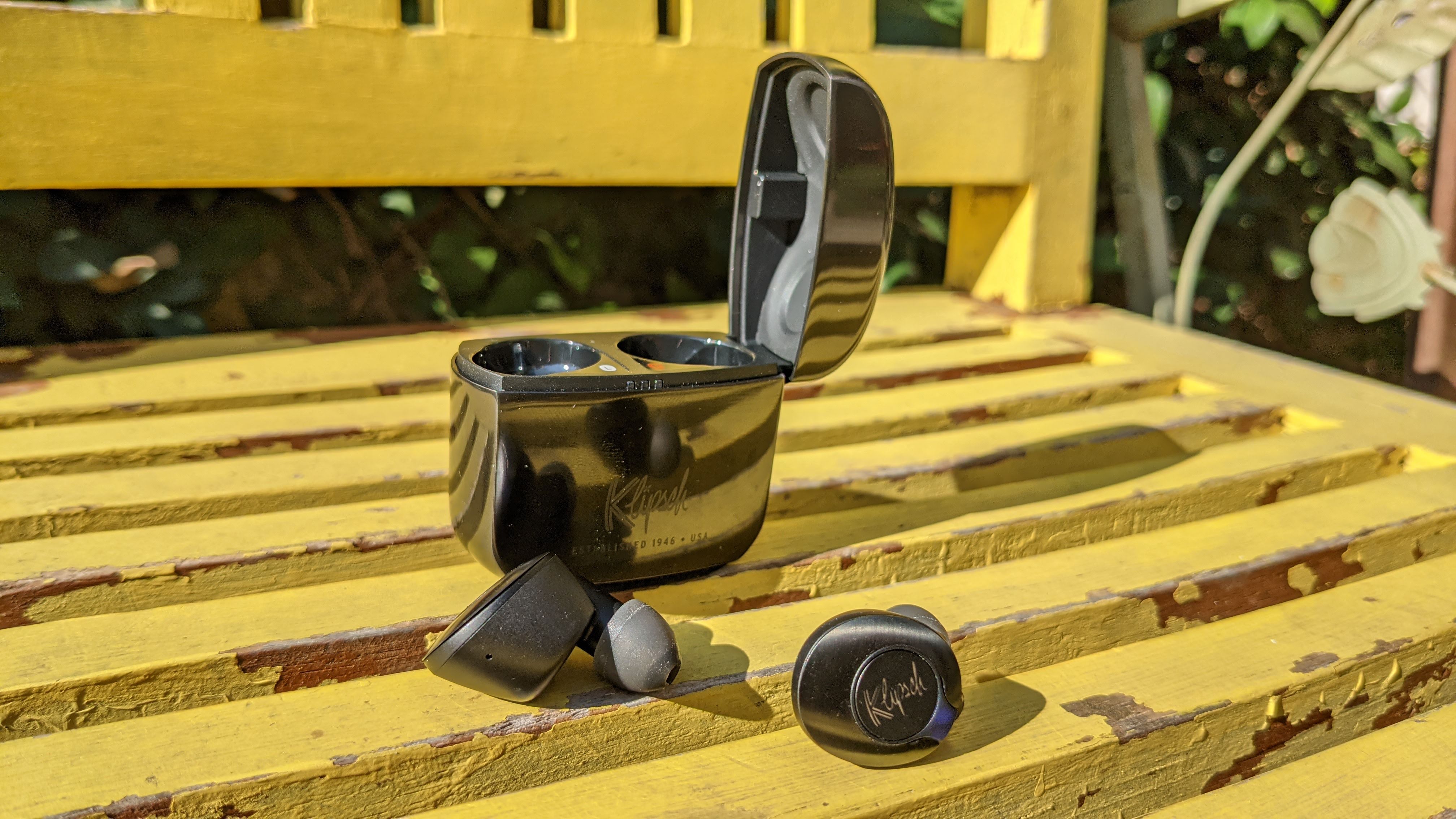TechRadar Verdict
While the Klipsch offer excellent sound quality, a premium design, decent noise-cancellation, and some unique features, they’re not as successful across the board as Sony’s WF-1000XM4 and the extra cost associated with them is more difficult to justify. If you’re after earbuds that you can control to some degree via head gestures, there are few alternatives.
Pros
- +
Remarkable audio with Dirac HD
- +
Premium design and feel
- +
Automated commands are a boon
Cons
- -
Pricey compared with competitors
- -
Average battery and no fast-charge
- -
ANC is solid but not the best
Why you can trust TechRadar
One-minute review
It’s natural to compare the Klipsch T5 II ANC to Sony’s class-leading WF-1000XM4 buds given their similar price points and feature sets, and while the Klipsch certainly make a solid case for themselves, they don’t quite offer as well-rounded a product as Sony’s slightly more affordable competition.
Available in three classy colors along with a limited (and more expensive) McLaren Edition, the T5 II ANC look classy and feel premium. The case is all-metal and hefty while the buds themselves are lightweight and comfortable, and both are tastefully styled.
A pair of soft-touch buttons (emblazoned with the Klipsch logo) allow you to painlessly take control, although customization of their functionality is limited to just the left bud. Six oval-shaped, silicon tips are included and – paired with the light weight of the buds – make fit and seal a breeze.
The Klipsch Connect app allows for all kinds of clever adjustments, including a six-band EQ, automations for enabling transparency mode when pausing music or taking calls, and settings to allow Bragi Moves’ head-nodding or shaking gestures to answer or decline calls or skip tracks.
The ANC on offer isn’t quite up to the standard that Sony and Bose have set, but it’s certainly capable and will serve perfectly well unless you need the absolute best. It’s a similar case with call quality, being about on-par with most of the true wireless market at the moment – good but not outstanding.
The audio quality of the T5 II ANC is where they truly shine – thanks to Dirac HD (an algorithmic enhancer with mysterious workings), the sound is rich and clear at once, offering punchy bass, pronounced mids and clarity between instruments.
With ANC enabled, you’ll get 5 hours out of the buds themselves with an extra 15 stored in the case, which is average for the industry but not great. The case sports wireless charging but there’s no fast-charge capabilities on offer.
The buds feature a Bluetooth 5.0 connection – not the latest, but not a dealbreaker either – and support for SBC and AAC codecs, which will be ample for the vast majority of listeners.
The Klipsch T5 II ANC are a great pair of true wireless earbuds and are largely let down by the stellar performance of their peers and the reduced cost at which the competition comes.

Klipsch T5 II True Wireless ANC price and release date
- $299 / £299 / AU$429
- Available now
- McLaren Edition for $349 / £379 / AU$499
The Klipsch T5 II True Wireless ANC earbuds are available now globally and priced at $299 / £299 / AU$429, making them pretty close competition to Sony’s class-leading WF-1000XM4 buds ($279 / £249 / AU$449).
In the UK, the Klipsch’s price is a considerable £50 jump over the Sony’s, whereas in the US the $20 difference is a little more palatable. In Australia, they’re technically AU$30 cheaper than Sony’s RRP but every retailer in the country is stocking the WF-1000XM4 at AU$389 by now, so it’s fair to say the Klipsch buds are pricier across the board.
There’s also a limited McLaren Edition model of the T5 II ANC that includes a wireless charging mat and a unique carbon fiber and tire-rubber finish on the case, but this model will set you back a rather luxurious $349 / £379 / AU$499.
Design and controls
- Premium, stylish and hefty case
- Soft-touch buttons
- Nodding and shaking head gesture control
From the outset, there’s no doubt that the Klipsch T5 II ANC are a premium pair of buds. The charging case feels like a fancy Zippo lighter with its considerable heft, metal casing and side-hinged flip-top lid. For some context on this solidity, the Klipsch’s case and buds weigh 82.4g (77g for just the case), twice that of the Sony WF-1000XM4 buds-and-case combo (41g).
They’re available in a stylish array of finishes – Gunmetal, Silver, Copper and a limited McLaren Edition – with each upholding the premium chic the brand is known for. While the finish on the case certainly feels nice and comforting to the touch, there’s no doubt that it’s also a fingerprint magnet (seen below).
One neat addition worth celebrating is the integrated rubber foot on the case’s base. Perhaps introduced to help keep the case secure on a wireless charging mat, its security translates to any surface you place the T5 II ANC on.

As for the earbuds themselves, the units are relatively compact and lightweight, enough so to sit comfortably in the ear and reduce fatigue when worn for extended periods. They also feature an IPX4 rating which, while rather low on the scale and a downgrade from the regular T5 II’s IP67 score, will still keep them safe from sweat and other light splashes (although the case does not share this protection).
They’re adorned with a button, each brandishing Klipsch’s cursive logo, along with a single large indicator LED surrounded by a trim featuring a different accent depending on your choice of color.
These buttons have a relatively soft actuation that isn’t the most satisfying to press, and although it doesn’t provide as much tactile feedback as some other buds, it does alleviate the issue of applying extra pressure to your ear canals when pressing them.
Within the Klipsch Connect app, you can customize the actions performed by these buttons, but oddly this is limited to just the left earbud. The usual array of options is present – playing, pausing, skipping, volume adjustment, ANC or transparency mode, answering or declining calls, and voice assistant activation are all here.
As for fit, there are a generous six included eartips in the box, all silicon and all sporting Klipsch’s patented oval-shaped design. We found the default medium tips to provide an easy and solid seal, and we imagine one of the other five options should suit most users’ ears if the standard tips don’t.
As compared to Sony and some other competitors, the T5 II ANC don’t feature any sensors to detect the proximity of your ear, which would allow for automatic pause and playback of music.
One of the most unique features of these buds is their integration with Bragi Moves – a system that allows head-movement gestures like nodding or shaking to activate certain controls (currently limited to answering or declining calls and skipping tracks). We found it to work reliably and as intended.
For those with physical impairments, we imagine this could be a god-send. For others, we suspect the infrequent cases in which you’d prefer not to touch the T5’s button would mean that you’d forget this functionality even existed, relegating it to the realm of novelty.
Audio and ANC
- Wonderfully clear and rich audio
- Decent but not class-leading ANC
- Excellent automated functions
As the product title may suggest, one of the main changes from the regular T5 II True Wireless earbuds is the addition of active noise cancellation (ANC), and while they perform admirably, they’re still no match for Sony’s competing buds or Bose’s exceptional noise-cancelling QuietComfort Earbuds.
Most static environmental noises are dealt with effectively thanks to the twin-mic ANC design (one feedback and one feedforward), but there is a low-level background noise introduced by the function itself, and more dynamic sounds like construction noise aren’t handled as elegantly as Sony and Bose manage it. Overall the ANC performance is great, but we’ve truly been spoilt for choice at this stage.
On the topic of microphones, there’s six beam-forming mics (three on each bud) that help with voice clarity when on calls. While they do a solid job, it’s a limitation of the true wireless format that you won’t be rivalling phone-to-face quality or even that from over-ear cans – the microphones are simply too far away from your mouth and are prone to picking up other external sounds as a result.
As is to be expected by this point, the T5 II ANC feature a transparency mode that allows external sound to enter the buds for the sake of awareness and conversation. This feels natural in practice and comes with a built-in noise shield to stop unexpected loud noises.
We previously mentioned the buds’ gesture control, but another feature that Klipsch’s integration of Bragi tech enables is called Sidekicks – essentially allowing for multiple settings to be enabled via a single command or action.
This includes automatically enabling transparency mode when on a call (excellent news for those that need to hear their own voice in order to speak properly), automatically engaging ANC when listening to music, and enabling transparency mode when pausing it.
These Sidekicks are genius and we’d love to see them integrated into more headphone designs (frankly, we’re surprised they’re not). We suspect the most common reason a listener pauses their music is in order to hear their surroundings, so why make this process require multiple commands or the removal of the buds altogether?

The T5 II ANC are the first true wireless earbuds to boast Dirac HD – a somewhat mysterious enhancement setting that Klipsch claims improves “staging, clarity, vocal crispness, and bass fidelity”.
As we hinted at, it’s difficult to pin down exactly what this setting does to work its magic, but we found the above claims to be accurate, with its particular frequency adjustments resulting in a more rich and 3D experience.
When engaging this feature, we couldn’t help but feel that these buds were designed specifically to sound good with it enabled, potentially sacrificing some of the vanilla audio fidelity in the process. This influence was by far the most prominent when toggling the mode on and off and hearing the direct comparison – although a few minutes of listening allowed us to acclimatize to either setting.
This enhancement mode makes it tricky to get a sense of the T5 II ANC's overall audio profile, but with Dirac HD engaged the response moves from being relatively flat to having more excited bass and upper-mids.
When put up against the WF-1000XM4, the T5’s bass is a little more punchy and the overall response feels a little less dampened in the high-end when Dirac HD is enabled, but when comparing the out-of-the-box sound, Sony’s signature warm profile was more pleasant and appeared less thin.
It’s a tasteful sound that provides exceptional clarity even at higher volumes, at which there’s no sign of distortion, and offers solid separation between musical components without disturbing the glue of the overall mix. If you’re not happy with the balance, the Klipsch Connect app provides a helpful 6-band EQ with each band’s associated frequency listed (something we’ve seen excluded from competitors too often).
The initial snare hit of MorMor's Heaven's Only Wishful is punctual and crisp, and throughout the track the Klipsch allows each synth and guitar component to comfortably coexist with the vocal rather than compete. The same is true during the song’s climax when a crunchy guitar solo is paired with an octave jump in the vocals, both delivered with a pleasant smoothness considering their abrasive nature.
In Off-Piste by Photay, the intro’s glitches are given three-dimensional life before being replaced with the off-kilter drop and kick-ducking bass. In a song where individual elements are threatened with being submerged in the wide-open wash of synth pads and sustained notes, the T5 do a remarkable job of distinguishing each melodic nuance and percussive dynamic.
On Deserta's shoegaze delight, Hide, this ability to create distinction is even more obvious – the delicate balance between an oppressing wall of noise and musical interplay is maintained without losing its sense of raw power.
For something a little softer, Westerman's 'Sketch' version of standout track Blue Commanche displays all the tenderness and faults that come with a demo recording. The characteristic slapback echo provides a rich sense of space to the mournful vocal delivery while the compressed acoustic guitar fills out the rest of the soundstage with gorgeous and intimate detail.
Battery and connectivity
- 5 + 15 hours with ANC on
- Wireless charging but no fast-charge
- Bluetooth 5.0 and SBC, AAC support
As we’ve mentioned, the charging case for the Klipsch T5 II ANC supports wireless charging, another upgrade from the regular T5 II buds, or you can plug it in via USB-C. Disappointingly, there’s no sign of fast-charging, which has become a rather standard inclusion in the earbud market and is a real lifesaver for those that are about to leave the house only to find the buds completely drained.
The battery life is fairly average for the industry – there’s 5 hours in the buds themselves with an extra 15 in the case (this extends to 7+21 if you forego ANC). By comparison, Sony’s WF-1000XM4 boast 8 hours in the buds and 16 in the case with ANC enabled, and the full package weighs half as much.
As for connectivity, the T5 II ANC features Bluetooth 5.0, which isn’t the latest standard – the WF-1000XM4 sports 5.2 while the QuietComfort Earbuds has 5.1. In practice, the differences between these technologies doesn’t yet have much of a real-world impact, but we always like to see the latest standard adopted to better futureproof products.
The Klipsch buds support SBC and AAC codecs, neither of which are especially hi-res but are capable of 320Kbps streams, which is more than enough for the majority of listeners relying on streaming services or on-device MP3s.
Should I buy the Klipsch T5 II True Wireless ANC?

Buy them if...
You’re chasing rich, detailed audio
The main highlight of these Klipsch buds is their excellent audio detail, with the Dirac HD technology offering truly rich and immersive audio. While audiophiles wanting to play lossless audio will be disappointed with the codec support, these buds still manage to breathe new life into compressed audio formats.
You want premium design and feel
The design of the T5 II ANC is indisputably premium, especially the schmick metal charging case, so if you’re after a stylish pair of buds with a case that feels good and can likely take a bit of a beating, these are the go.
You need gesture control and some automation
While the head-nodding and shaking gestures offered by Bragi Moves may be a novelty to some, it could be a gamechanger for those with accessibility needs. We’re also incredibly fond of Bragi’s Sidekicks, which allow for clever automations to disable or enable ANC in appropriate situations.
Don't buy them if...
You’d prefer to save some money for similar performance
The premium brand, design and audio come at quite the cost with these earbuds – the retail price is above that of the Sony WF-1000XM4, which we find to excel on all fronts to produce an especially well-rounded product.
You’re after the best-in-class noise-cancellation
As we’ve mentioned in our review, Sony and Bose both outclass Klipsch on the ANC front, and while the offering is certainly respectable here, we’d recommend looking at an alternative at this price if it’s a priority of yours.

